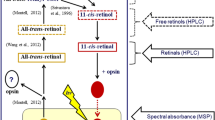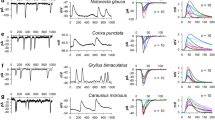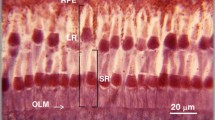Summary
The rhabdoms ofLeptograpsus variegatus photoreceptors are several times larger at night than in the day. In animals kept in the laboratory and accustomed to a cycle of fluorescent light turned on and off at approximately natural dawn and dusk times, photoreceptors generally form new rhabdomeres within 30–60 min of the beginning of the dark period. At the beginning of the light period a large proportion of these rhabdomeres are removed by pinocytosis, leaving the smaller day rhabdomeres which persist until the following ‘dusk’, when they are rapidly broken down and replaced by newly synthesized phototransductive membrane. It is shown that;
-
(i)
Synthesis occurs if crabs are dark adapted several hours before the usual dark period, but the final rhabdom size is reduced.
-
(ii)
Crabs maintained in light through the usual dark period synthesize a new rhabdom.
-
(iii)
Synthesis as a reaction to early darkness occurs unilaterally if one eye is blinded.
An unusual turnover schedule recently proposed forLimulus lateral eye is discussed in relation to some earlier studies onLimulus light and dark adaptation and recent work on turnover in other arthropods. It is concluded thatLimulus very probably complies with the turnover schedule emerging as normal for animals that have enlarged rhabdoms at night.
Similar content being viewed by others
References
Barlow RBJr, Chamberlain SC (1980) Light and a circadian clock modulate structure and function inLimulus photoreceptors. In: Williams TP, Baker BN (eds) The effects of constant light on visual processes. Plenum, New York London, pp 247–270
Behrens M (1974) Photomechanical changes in the ommatidia of theLimulus lateral eye during light and dark adaptation. J Comp Physiol 89:45–57
Behrens M, Krebs W (1976) The effect of light-dark adaptation on the ultrastructure ofLimulus lateral eye retinular cells. J Comp Physiol 107:77–96
Blest AD (1978) The rapid synthesis and destruction of photoreceptor membrane by a dinopid spider: a daily cycle. Proc R Soc London Ser B 200:463–483
Blest AD, Day WA (1978) The rhabdomere organisation of some nocturnal pisaurid spiders in light and darkness. Philos Trans R Soc Lond [Biol] 283:1–23
Blest AD, Stowe S, Price GD (1980) The sources of acid hydrolases for photoreceptor membrane degradation in a grapsid crab. Cell Tissue Res 205:229–244
Chamberlain SC, Barlow RBJr (1977) Morphological correlates of efferent circadian activity and light adaptation in theLimulus lateral eye. Biol Bull 153:418–419
Chamberlain SC, Barlow RBJr (1979) Light and efferent activity control rhabdom tunrover inLimulus photoreceptors. Science 206:361–363
Debaisieux P (1944) Les yeux de crustacés: structure, développement, réactions à l'éclairement. Cellule 50:2–122
Eguchi C, Waterman TH (1967) Changes in retinal fine structure induced in the crabLibinia by light and dark adaptation. Z Zellforsch 79:209–229
Hafner GS, Hammond-Soltis G, Tokarksi T (1980) Diurnal changes of lysosome-related bodies in the crayfish photoreceptor cells. Cell Tissue Res 206:319–332
Horridge GA (1978) The separation of visual axes in apposition compound eyes. Philos Trans R Soc Lond [Biol] 285:1–59
Horridge GA, Blest AD (1980) The compound eye. In: Smith DS, Locke M (eds) The future of insect biology. Essays presented to Sir Vincent Wigglesworth on his 80th birthday. Academic Press, New York
Horridge GA, Duelli P (1979) Anatomy of the regional differences in the eye of the mantisCiulfina. J Exp Biol 80:165–190
Horridge GA, Duniec J, Marčelja L (1980) A 24-hour cycle in single locust and mantis photoreceptors. J Exp Biol (in press)
Itaya SK (1976) Rhabdom changes in the shrimpPalaemonetes. Cell Tissue Res 166:256–273
Larimer JL, Smith JTF (1980) Circadian rhythm of retinal sensitivity in crayfish: modulation by the cerebral and optic ganglia. J Comp Physiol 136:313–326
Laughlin SB, Blest AD, Stowe SJ (1980) Receptor responses and lens properties of the posterior lateral eyes ofDinopis (Araneae). J Comp Physiol (in press)
Ludolph C, Pagnanelli D, Mote MI (1973) Neural control of migration of proximal screening pigment by retinula cells of the swimming crabCallinectes sapidus. Biol Bull 145:159–170
Miller WH (1975) Mechanisms of photomechanical movement. In: Snyder AW, Menzel R (eds) Photoreceptor optics. Springer, Berlin Heidelberg New York, pp 415–428
Miller WH, Cawthon DF (1974) Pigment granule movement inLimulus photoreceptors. Invest Ophthalmol 13:401–405
Nässel DR, Waterman TH (1979) Massive diurnally modulated photoreceptor membrane turnover in crab light and dark adaptation. J Comp Physiol 131:205–216
Rossel S (1979) Regional differences in photoreceptor performance in the eye of the praying mantis. J Comp Physiol 131:95–112
Sanchez JA, Fuentes-Pardo B (1977) Circadian rhythm in the amplitude of the electroretinogram in the isolated eyestalk of the crayfish. Comp Biochem Physiol 56A:601–605
Sandeman DC (1978) Regionalization in the eye of the crabLeptograpsus variegatus: Eye movements evoked by a target moving in different parts of the visual field. J Comp Physiol 123:299–306
Stowe S (1980a) Rapid synthesis of photoreceptor membrane and assembly of new microvilli in a crab at dusk. Cell Tissue Res 211:419–440
Stowe S (1980b) Spectral sensitivity and retinal pigment movement in the crabLeptograpsus variegatus (Fabricius). J Exp Biol 87:73–98
Williams DS, Blest AD (1980) Extracellular shedding of photoreceptor membrane in the open rhabdom of a tipulid fly. Cell Tissue Res 205:423–438
White RH (1967) The effects of light and light deprivation upon the ultrastructure of the larval mosquito eye. II. The rhabdom. J Exp Zool 166:405–426
White RH (1968) The effect of light and light deprivation upon the ultrastructure of the larval mosquito eye. III. Multivesicular bodies and protein uptake. J Exp Zool 169:261–278
Author information
Authors and Affiliations
Additional information
I thank members of the Electron Microscope Unit for their support, and A.D. Blest, D.S. Williams, and S.R. Shaw for helpful discussion. Bruce Ham helped in collection of crabs, and Pam Coote in the preparation of the manuscript.
Rights and permissions
About this article
Cite this article
Stowe, S. Effects of illumination changes on rhabdom synthesis in a crab. J. Comp. Physiol. 142, 19–25 (1981). https://doi.org/10.1007/BF00605472
Accepted:
Issue Date:
DOI: https://doi.org/10.1007/BF00605472




